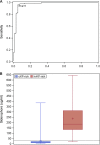Identification of Biomarkers for Differentiation of Hypervirulent Klebsiella pneumoniae from Classical K. pneumoniae
- PMID: 29925642
- PMCID: PMC6113484
- DOI: 10.1128/JCM.00776-18
Identification of Biomarkers for Differentiation of Hypervirulent Klebsiella pneumoniae from Classical K. pneumoniae
Abstract
A hypervirulent Klebsiella pneumoniae (hvKp) pathotype is undergoing global dissemination. In contrast to the usual health care-associated epidemiology of classical K. pneumoniae (cKp) infections, hvKp causes tissue-invasive infections in otherwise healthy individuals from the community, often involving multiple sites. An accurate test to identify hvKp strains is needed for improved patient care and epidemiologic studies. To fill this knowledge gap, clinical criteria or random blood isolates from North American and United Kingdom strain collections were used to assemble hvKp-rich (n = 85) and cKp-rich (n = 90) strain cohorts, respectively. The isolates were then assessed for multiple candidate biomarkers hypothesized to accurately differentiate the two cohorts. The genes peg-344, iroB, iucA, plasmid-borne rmpA gene ( prmpA), and prmpA2 all demonstrated >0.95 diagnostic accuracy for identifying strains in the hvKp-rich cohort. Next, to validate this epidemiological analysis, all strains were assessed experimentally in a murine sepsis model. peg-344, iroB, iucA, prmpA, and prmpA2 were all associated with a hazard ratio of >25 for severe illness or death, additionally supporting their utility for identifying hvKp strains. Quantitative siderophore production of ≥30 μg/ml also strongly predicted strains as members of the hvKp-rich cohort (accuracy, 0.96) and exhibited a hazard ratio of 31.7 for severe illness or death. The string test, a widely used marker for hvKp strains, performed less well, achieving an accuracy of only 0.90. Last, using the most accurate biomarkers to define hvKp, prevalence studies were performed on two Western strain collections. These data strongly support the utility of several laboratory markers for identifying hvKp strains with a high degree of accuracy.
Keywords: biomarkers; classical Klebsiella pneumoniae; diagnosis; diagnostic test; hypervirulent Klebsiella pneumoniae.
Copyright © 2018 American Society for Microbiology.
Figures


References
-
- Conlan S, Thomas PJ, Deming C, Park M, Lau AF, Dekker JP, Snitkin ES, Clark TA, Luong K, Song Y, Tsai YC, Boitano M, Dayal J, Brooks SY, Schmidt B, Young AC, Thomas JW, Bouffard GG, Blakesley RW, Mullikin JC, Korlach J, Henderson DK, Frank KM, Palmore TN, Segre JA. 2014. Single-molecule sequencing to track plasmid diversity of hospital-associated carbapenemase-producing Enterobacteriaceae. Sci Transl Med 6: 254ra126. doi:10.1126/scitranslmed.3009845. - DOI - PMC - PubMed
Publication types
MeSH terms
Substances
Grants and funding
LinkOut - more resources
Full Text Sources
Other Literature Sources
Medical
Miscellaneous

